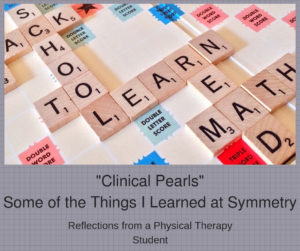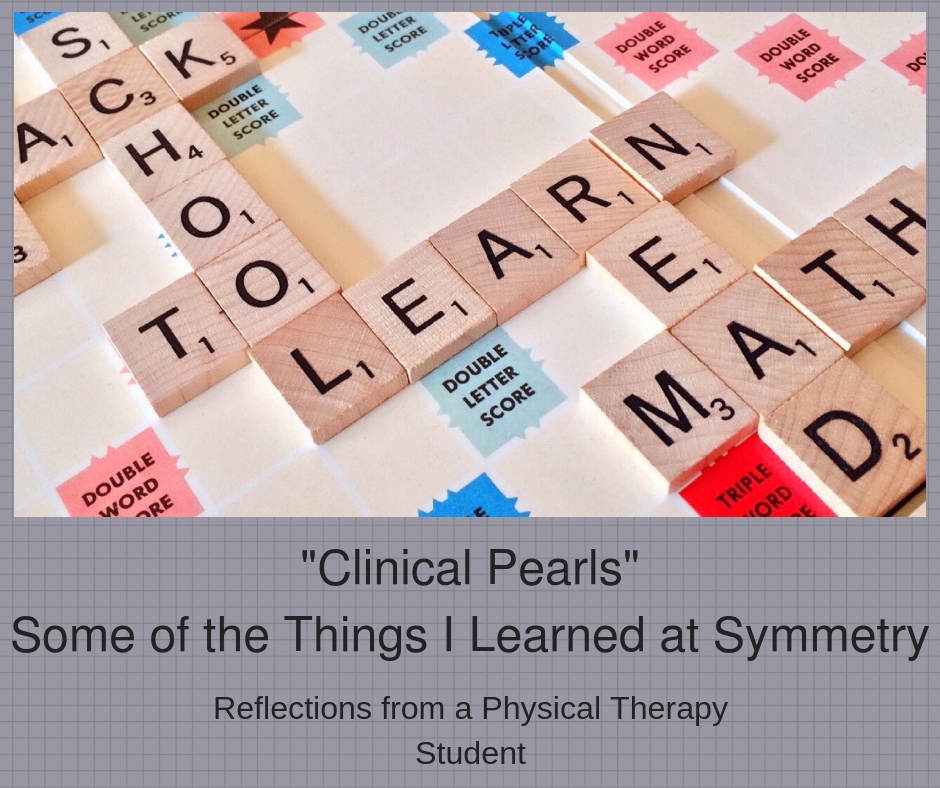
This post was written by Justin Papke, SPT from Texas State University. Thanks, Justin!
As a graduate student starting my third (and final) year of my clinical doctorate in physical therapy (DPT), I had no idea what to expect going out on my “clinical rotations.” I specifically selected an internship at Symmetry after reviewing a long list of clinics in the Austin area, based on guidance from my professors, past student reviews, and my own personal research. This would be my first outpatient physical therapy experience in an orthopedic setting. I was equally nervous and excited when I was told that I had been approved to do my first eight weeks in the Symmetry clinic. Not knowing what to expect, I was welcomed into the team immediately on my first day and found that both Symmetry’s staff and their patients were warm, friendly, and supportive. As I come to the end of my clinical experience at Symmetry, I thought I’d share a few of the things that I have learned here over the last several weeks.
- Pelvic alignment plays a much larger role in back pain syndromes than I initially realized. Pelvic position and movement are much more complex than I expected. As the body is a 3D structure, it is possible for it to get out of alignment in multiple planes at one time. It turns out that much of the information regarding pelvic function typically is taught toward the end of post-graduate manual therapy fellowship training because it is quite complex, even compared to the information I received while doing my doctorate. So in short, I have learned that there is more to consider clinically in the low back and pelvic area than I expected. I was overjoyed to have the opportunity to get a leg-up on this training, as it will undoubtedly play a huge role in the health and function of my patients with back pain in the future.
- I know more than I think I know. Julie and Brad (my two clinical instructors at Symmetry) have done a great job helping me to take all of the information I have learned over the last two years in a classroom and make clinical sense of it. There have so many “a-ha moments” during my time at Symmetry when I have realized how the science I had learned contributed to the hands-on techniques they were using with patients or the exercises and corrective movement strategies they were teaching. Expanding on the personal training background that I had prior to physical therapy school, it has been great to see how the small “tweaks” we can make to exercises can completely change their purpose and effects. One example of this is in a “side-lying open book” exercise for spinal mobility. Performing this exercise with the bottom knee straight out and the top knee bent allows the lumbar and thoracic spine to rotate altogether. However, if you want to focus on the rotation in the thoracic spine without compensation from the lumbar spine, simply bending both knees and pulling them toward the chest will allow much less lumbar movement and will isolate the rotation to the thoracic spine. Learning new techniques like this over the last several weeks has allowed my confidence in my knowledge (and ability to use that knowledge to make a difference in someone’s pain and function) to grown immensely, and I am realizing just how much I have learned over the last two years.
- There is still so much more to learn. During my clinical rotation at Symmetry, I have been exposed to many new screening, assessment, and manual treatment techniques that I had not previously seen. I have learned that there are often multiple ways to find and treat physical dysfunction, and that some methods work better for different therapists or for different patients. For example, we may have learned one or two techniques in PT school that may only be performed with the patient lying on their back. But you may encounter a patient that does not tolerated lying in this position for very long, so another technique or a variation on the first one may need to be used. I have learned so many new hands-on treatments at Symmetry that have allowed me to perform similar techniques in various positions in order to fit the needs of the patients. From another angle, I have learned that some techniques work better for therapists with larger frames than they do for smaller therapists. During this rotation I have learned that each therapist can find ways to create and alter their hands-on treatments to fit their own body and physical abilities. Understanding that there will always be more to learn and ways to better myself as a PT has been a large part of my education, but nothing compares to understanding what that looks like first-hand. Being a physical therapist means constantly learning, growing, and adapting with the use of new knowledge, research, and techniques. This is one of the things I love most about the profession.
These examples represent only a handful of the countless things I have learned over the last few short weeks, but they are some of the points I thought were significant for sharing with future students and potential patients. My clinical experience at Symmetry has taken my level of expertise, confidence, and understanding of physical therapy practice to new levels, and I would gladly recommend this clinic to future students and patients alike. The qualities I have developed over the course of this rotation will stay with me throughout my career as a PT and will continue to grow as I gain experience in the field. That, in short, is the biggest “clinical pearl” that I can imagine.

